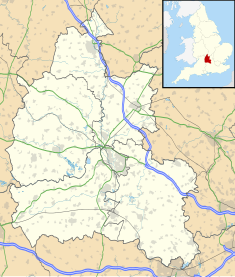Chipping Norton Town Hall
| Chipping Norton Town Hall | |
|---|---|
 Chipping Norton Town Hall | |
| Location | Market Place, Chipping Norton |
| Coordinates | 51°56′28″N 1°32′44″W / 51.9411°N 1.5456°W |
| Built | 1842 |
| Architect | George Stanley Repton |
| Architectural style(s) | Palladian style |
Listed Building – Grade II* | |
| Official name | Town Hall, Market Place |
| Designated | 23 April 1952 |
| Reference no. | 1183188 |
Chipping Norton Town Hall is a municipal building in the Market Place, Chipping Norton, Oxfordshire, England. The building, which is used as an events venue, is a Grade II* listed building.[1]
History[edit]
The first municipal building in the town was a guildhall which was built for the Guild of the Holy Trinity in 1520.[2] Following the dissolution of the chantries in 1548, the guildhall was acquired by the town and subsequently used by civic leaders as their meeting place.[3][a] In the early 1840s, the local member of parliament, James Langston, led a campaign to commission a more substantial structure.[6] The site he selected was occupied by an ancient market house with nine pillars and a pyramid-shaped roof which was demolished to make way for the new structure.[7]
The new building was designed by George Stanley Repton in the Palladian style, built in ashlar stone and was completed in 1842.[1] The design involved a symmetrical main frontage with nine bays facing onto the east side of the High Street. It featured a flight of seven steps leading up to a tetrastyle portico with Doric order columns supporting an entablature and a pediment; there were niches in the outer bays on the front elevation.[1] The western elevation was arcaded on the ground floor and was fenestrated by seven tall sash windows flanked by pilasters supporting an entablature; there were again niches in the end bays, which slightly projected forward. The end elevations were arcaded on the ground floor and were fenestrated by rows of three sash windows flanked by pilasters supporting entablatures and pediments. The northern pediment contained a clock in the tympanum and was surmounted by a bellcote.[1] Internally, the principal rooms on the ground floor were the four cells for the incarceration of pretty criminals, the weighbridge for measuring the weight of goods being traded and the space for the horse-drawn fire engine, while the principal room on the first floor was the council chamber which was also used as a court room.[8]
A grand dinner was held in the town hall in August 1855 to celebrate the official opening of the Chipping Norton Railway.[9] A weather vane, designed in the form of a foxhound, was presented to the town by the Heythrop Hunt and installed at the top of the bellcote in March 1950.[8] The building was badly damaged in a fire on 3 March 1950: while the shell of the building survived, much of the interior was destroyed.[10] It continued to serve as the local seat of government until the enlarged West Oxfordshire District Council was formed at Witney in 1974,[11] and subsequently continued to be used as a venue for major events such as the local Brexit debate in June 2016.[12]
Works of art in the town hall include a portrait by Walter William Ouless of the member of parliament, Albert Brassey,[13] a portrait by Edward S. Harper of the former mayor, Alderman Henry Field Wilkins[14] and a portrait by an unknown artist of the local politician, James Langston.[15]
See also[edit]
Notes[edit]
- ^ The guildhall was subsequently auctioned and used by private owners for a variety of purposes before being acquired by the former member of parliament, Albert Brassey, in 1902.[4] Brassey presented it to the borough council and it was subsequently used as a classroom, as a library and also as the town clerk's office.[5]
References[edit]
- ^ a b c d Historic England. "Town Hall, Market Place (1183188)". National Heritage List for England. Retrieved 27 January 2022.
- ^ Historic England. "Guildhall (1052632)". National Heritage List for England. Retrieved 27 January 2022.
- ^ Cliffe, Janice; Rosen, Adrienne (2017). The Making of Chipping Norton: The Making of Chipping Norton A Guide to Its Buildings and History to 1750. History Press. p. 98. ISBN 978-0750984867.
- ^ "The Guildhall in Chipping Norton: The News asked local historian Janice Cliffe about the background and significance of the guildhall". Chipping Norton News. 18 April 2021.
- ^ "No. 40028". The London Gazette. 27 November 1953. p. 6450.
- ^ "James Haughton Langston". Churchill Heritage. Retrieved 27 January 2022.
- ^ Cliffe and Rosen 2017, frontispiece.
- ^ a b "Chipping Norton". Cotswolds Info. Retrieved 27 January 2022.
- ^ Watkins, Alan; Morris, Brenda (2014). Chipping Norton Railway. Amberley Publishing. ISBN 978-1445618630.
- ^ "Chipping Norton Town Hall" (PDF). Chipping Norton Town Council. Retrieved 27 January 2022.
- ^ Local Government Act 1972. 1972 c.70. The Stationery Office Ltd. 1997. ISBN 0-10-547072-4.
- ^ "EU debate: Chipping Norton host Question Time style event". Oxford Mail. 15 June 2016. Retrieved 27 January 2022.
- ^ Ouless, Walter William. "Albert Brassey, Esq. (1844–1914), MA, JP, MFH, MP of Heythrop Park". Art UK. Retrieved 27 January 2022.
- ^ Harper, Edward Samuel. "Alderman Henry Field Wilkins, Mayor of Chipping Norton (1836, 1853, 1861, 1868, 1874, 1876 & 1886)". Art UK. Retrieved 27 January 2022.
- ^ "James Houghton Langston of Sarsden, Esq. (1796–1863), MP". Art UK. Retrieved 27 January 2022.

